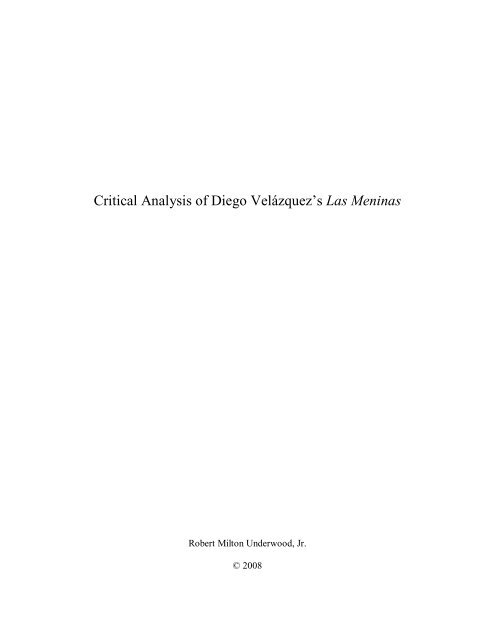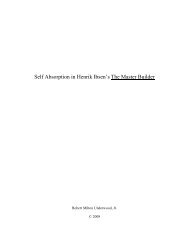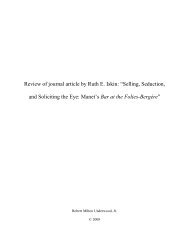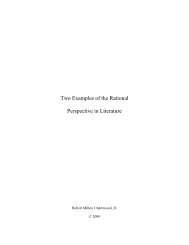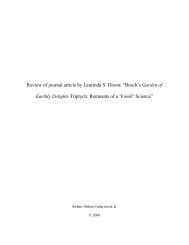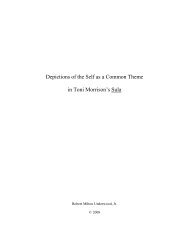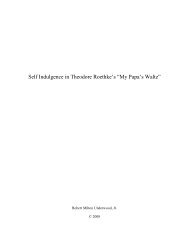Critical Analysis of Diego Velázquez's Las Meninas
Critical Analysis of Diego Velázquez's Las Meninas
Critical Analysis of Diego Velázquez's Las Meninas
Create successful ePaper yourself
Turn your PDF publications into a flip-book with our unique Google optimized e-Paper software.
<strong>Critical</strong> <strong>Analysis</strong> <strong>of</strong> <strong>Diego</strong> Velázquez’s <strong>Las</strong> <strong>Meninas</strong><br />
Robert Milton Underwood, Jr.<br />
© 2008
<strong>Critical</strong> <strong>Analysis</strong> <strong>of</strong> <strong>Diego</strong> Velázquez’s <strong>Las</strong> <strong>Meninas</strong><br />
Underwood 1<br />
Very few works <strong>of</strong> art can be described as brilliant masterpieces. That is surely the very<br />
least that can be written about <strong>Las</strong> <strong>Meninas</strong> by <strong>Diego</strong> Velázquez, a group portrait <strong>of</strong> the court <strong>of</strong><br />
Spanish King Philip IV. It has been studied by artists and critics alike not only for its technical<br />
mastery, but also because <strong>of</strong> the many symbolic representations it contains. Madlyn Millner Kahr<br />
wrote in her essay, “Velázquez and <strong>Las</strong> <strong>Meninas</strong>,” that indeed Velázquez created something<br />
truly extraordinary, and she suggested likely influences he may have had. She also wrote that<br />
Velázquez had a greater purpose in mind when he created the masterpiece—he wanted to gain a<br />
coveted title that would ensure him a high place in society. Kahr discussed three major issues in<br />
her essay. She described the painting itself, suggested the likelihood <strong>of</strong> Flemish influences, and<br />
also discussed Velázquez’s desire for an aristocratic title greater than any single court position he<br />
could hold. He wanted ennoblement.<br />
<strong>Las</strong> <strong>Meninas</strong> is a masterpiece indeed. “The picture is unbelievably complex, a kind <strong>of</strong><br />
exercise in dexterity that only an established painter would attempt in order to prove that he<br />
could do it. The various planes are indicated by perspective, the interplay <strong>of</strong> light and dark, and a<br />
clever use <strong>of</strong> colors. The figures are well done and breathe vitality, but the essential mystery <strong>of</strong><br />
this work lies outside such considerations” (Michener 407). Velázquez’s amazing work relies on<br />
the effect <strong>of</strong> the brushwork, and on the delicate harmony <strong>of</strong> the colors, shapes, and individuals<br />
depicted. He may be one <strong>of</strong> the top painters who ever lived, and his <strong>Las</strong> <strong>Meninas</strong> may “… well<br />
be the most thrilling portrayal <strong>of</strong> humanity ever created, a combination <strong>of</strong> portrait, self portrait,<br />
illusion, reality, dream, romance, likeness and propaganda ever painted…” (Hoving 226). His<br />
esteemed masterpiece certainly contains all <strong>of</strong> these qualities, and many more.
Underwood 2<br />
The artist was born <strong>Diego</strong> Rodriguez de Silva y Velázquez in Seville, Spain. He showed<br />
artistic talent early on, and was sent at a young age by his parents to study with master painter<br />
Francisco Herrera. But young <strong>Diego</strong> soon wanted more artistic freedom so he decided to join the<br />
studio <strong>of</strong> Francisco Pacheco. From Pacheco, he learned not only the fine art <strong>of</strong> painting, but<br />
matured into young adulthood by also being taught literature and philosophy. It was under the<br />
apprenticeship <strong>of</strong> Pacheco that he developed his naturalistic style (Hoving 226). He began by<br />
painting scenes <strong>of</strong> the common people, and these were carefully drawn in natural settings or from<br />
models he may have used at the time. Still-life paintings weren’t held in high regard at the time,<br />
but Pacheco said that they should be “if they were painted as Velázquez painted them” (48).<br />
With that statement, he acknowledged that his pupil had surpassed him in talent. When<br />
Velázquez was 20 he married Juana, the<br />
daughter <strong>of</strong> Pacheco, and eventually had<br />
two daughters with her.<br />
Before discussing Kahr’s description<br />
<strong>of</strong> the painting, it is worthwhile to be aware<br />
<strong>of</strong> the elements <strong>of</strong> the painting itself. The<br />
scene in <strong>Las</strong> <strong>Meninas</strong> (Figure 1) is both<br />
structured and united through the use <strong>of</strong><br />
color and light. <strong>Las</strong> <strong>Meninas</strong> is an oil on<br />
canvas painting, is approximately 318 by<br />
276 centimeters in size, was completed in<br />
Fig. 1: <strong>Diego</strong> Velázquez, <strong>Las</strong> <strong>Meninas</strong><br />
1656, and had been held in the Spanish royal collections until the opening in 1819 <strong>of</strong> the Museo<br />
del Prado in Madrid, Spain. The painting was identified as El Cuadro de la Familia in
Underwood 3<br />
seventeenth-century inventories <strong>of</strong> the Royal Palace at Madrid (Martin 337). It was listed as La<br />
Familia de Felipe IV in 1734, but was not given its popular title <strong>Las</strong> <strong>Meninas</strong> 1 until 1843 (Kahr<br />
228). The alteration in title changed the focus from the royal family to the young female<br />
attendants. They were girls from aristocratic families who were brought up to serve at court, but<br />
were not royalty themselves. The final change in title might be a reflection <strong>of</strong> the change in<br />
attitude about contemporary women, or as a shifting <strong>of</strong> the perception <strong>of</strong> feminine ideals<br />
(Luxenberg 25).<br />
<strong>Las</strong> <strong>Meninas</strong> unfolds on several different planes within a high-ceilinged, sparsely<br />
furnished room <strong>of</strong> the royal palace. Seven conspicuous planes are (i) a canvas being painted by<br />
Velázquez, (ii) a dog and a midget, (iii) the little princess with her maids <strong>of</strong> honor and a dwarf,<br />
(iv) Velázquez himself, (v) a man and a woman, (vi) a mirror on a wall with other paintings, and<br />
(vii) a man in a doorway.<br />
Antonio Palomino, who published a biography 2 <strong>of</strong> Spanish painters in 1724, identified<br />
the individuals in the painting (Stratton-Pruitt 2-3). The central focal point is the royal princess,<br />
Doña Margarita María <strong>of</strong> Austria, also referred to as The Infanta. Attending to her are two <strong>of</strong> the<br />
Queen’s maids <strong>of</strong> honor, Doña María Agustina on the left, and Doña Isabel de Velasco on the<br />
right. We also see Velázquez himself standing back from the easel. Behind Doña Isabel are two<br />
older individuals—Doña Marcela de Ulloa, and an unnamed Guarda Damas 3 . In a doorway at the<br />
very back <strong>of</strong> the painting stands José Nieto, the Queen’s chamberlain, and to the left <strong>of</strong> him on<br />
the back wall is a mirrored reflection <strong>of</strong> the king and queen. The foremost image is that <strong>of</strong> the<br />
passive dog. With his foot on the dog is the midget Nicolasito Pertusato, and next to him is the<br />
1 Menina was originally the Portuguese word for “girl.”<br />
2 Originally titled, El Parnaso Español Pintoresco Laureado<br />
3 A male escort for ladies <strong>of</strong> the court
Underwood 4<br />
dwarf Maribárbola 4 . The commonality <strong>of</strong> all <strong>of</strong> these figures is that they are all members <strong>of</strong> the<br />
royal dwelling. The act <strong>of</strong> placing himself in the painting shows us that Velázquez believes that<br />
he deserves to be in their company.<br />
An essential component <strong>of</strong> all Baroque painting is light. Baroque artists largely gave up<br />
the Renaissance convention <strong>of</strong> centralizing a single subject with light. They chose instead to use<br />
light in such a way as to establish several focal points within a painted work. Light can be used<br />
to craft a poetic atmosphere and, “The gossamer effect <strong>of</strong> this light (in <strong>Las</strong> <strong>Meninas</strong>) prevents the<br />
whole from breaking down into individual parts. Instead, the atmosphere unites the disparate<br />
elements <strong>of</strong> the painting, while questions raised by this painting about the nature <strong>of</strong> vision and<br />
pictorial reality give it a cryptic quality” (Triadó 65). Indeed, the light in this painting seems<br />
confusing. It appears to be coming from slightly above horizontal center and <strong>of</strong>f to the right. The<br />
face <strong>of</strong> the princess is illuminated from up and slightly to the right. But since the part in the hair<br />
<strong>of</strong> the female dwarf is illuminated, and her right cheek is shadowed, and since the little boy’s<br />
face is totally in shadow, the light must be coming from slightly behind the plane that the dwarf<br />
is on. But if this is the case, it is difficult to explain how the mirror in the background seems so<br />
uniformly illuminated. Contrary to the adage that “mirrors never lie,” Kahr suggests that the<br />
mirror “hints at its own unreality” (243).<br />
The light does not seem to be evenly reflected in <strong>Las</strong> <strong>Meninas</strong>. The man and woman<br />
standing behind the maid to the right appear to be only about five or six feet behind her, but they<br />
are completely in shadows. Starting with the illuminated face <strong>of</strong> Margarita, we notice decreasing<br />
clarity and illumination as we proceed at an angle slightly up and to the right to the standing<br />
maid, the woman, and then the man. The primary light definitely comes from the upper right<br />
somewhere, perhaps in the adjacent room, and this shows itself well on the face <strong>of</strong> Velázquez,<br />
4 Kahr references these two individuals with different spellings, as “Nicolasico Pertusato,” and “Mari Barbola.”
Underwood 5<br />
whose dominant point <strong>of</strong> illumination is just above and slightly to the right <strong>of</strong> his left brow.<br />
Palomino pr<strong>of</strong>fered a description <strong>of</strong> the light source by writing that “this gallery has several<br />
windows seen in diminishing size, which makes its depth seem great; the light enters through<br />
them from the left, but only from the first and last ones” (Pacheco and Palomino 148).<br />
The elements <strong>of</strong> light and color are just part <strong>of</strong> why Velázquez’s work is considered a<br />
masterpiece. Frederic Taubes wrote that “the overall mastery in the use <strong>of</strong> pictorial means, the<br />
fact that it (<strong>Las</strong> <strong>Meninas</strong>) stands at the highest level any artist could attain, would not alone<br />
establish the painting in the galaxy <strong>of</strong> masterpieces. It is rather the imponderable that raises the<br />
realistic representation to the sphere <strong>of</strong> the transcendental” (106). He thought that even the dog in<br />
the painting had a surreal aura <strong>of</strong> contentment considering the action going on around it.<br />
Velázquez was a master <strong>of</strong> brushwork, and a virtuoso with his tools. His brushwork<br />
highlights and distinguishes the various textures in the clothing worn by the people in the<br />
painting. “In each polarity, black and white, there are exquisite refinements” (Rosenblum and<br />
Janson 279). Velázquez would occasionally use long-handled brushes that allowed him to stand a<br />
little farther from the canvas, enabling a slightly improved quality for the viewer <strong>of</strong> the finished<br />
work (M<strong>of</strong>fit 161).<br />
Velázquez had been appointed the king’s painter at the age <strong>of</strong> 25 after the king had been<br />
impressed with three prior portraits. Artists had served kings for centuries, and were <strong>of</strong>ten a<br />
member <strong>of</strong> the royal court, albeit a member <strong>of</strong> low status. Greater prestige for the artist was<br />
possible through the succession <strong>of</strong> promotions within the court. Palomino provided the various<br />
succession <strong>of</strong> positions for Velázquez, starting with Painter to the Bedchamber (1623), Usher to<br />
the King’s Bedchamber (1627), Gentleman <strong>of</strong> the Wardrobe, Gentleman <strong>of</strong> the Bedchamber
Underwood 6<br />
(1642) and Chief Chamberlain <strong>of</strong> the Palace (1652). But Velázquez aspired to a still greater<br />
honor, the highest in Spain at the time for an aristocrat—the royal Order <strong>of</strong> Santiago.<br />
Velázquez had the favorable position <strong>of</strong> being the keeper <strong>of</strong> pictures for Philip IV, “…a<br />
more enviable position no painter has ever achieved” (Taubes 105). Admiring the king’s<br />
collection “…confirmed in him his natural predilection for the painterly and his indifference to<br />
the more linear tradition (Honour, Hugh and Fleming 595). King Philip IV actually sent him to<br />
Italy on two occasions around 1649 to 1650 to acquire paintings and antiques. On these two trips,<br />
he was very impressed with sixteenth-century Venetian painting, especially that <strong>of</strong> Tintoretto and<br />
Titian. As Velázquez matured as a painter, he preferred more painterly 5 colors. By using hues<br />
with very little contrast between them, he was able to create a s<strong>of</strong>t, darkish atmosphere. The<br />
colors that predominated in Spanish paintings around the time <strong>of</strong> this work were ochre tones,<br />
earthy reds and yellows.<br />
Kahr provided examples <strong>of</strong> painters who likely influenced Velázquez. They were from<br />
Antwerp, Belgium, or nearby and included Frans Francken II, Hieronymus II, Willem van<br />
Haecht II, Johan Wierix, Hans Burgkmair, Lucas Vorsterman and David Teniers II. He was<br />
likely influenced by a class <strong>of</strong> paintings known as “Gallery Pictures,” that were primarily<br />
Flemish in origin. They were distinct in that they were paintings <strong>of</strong> groups <strong>of</strong> people doing<br />
ordinary things inside, and with the far wall <strong>of</strong> the subject room being parallel to the picture<br />
plane (Kahr 229).<br />
The context <strong>of</strong> the <strong>Las</strong> <strong>Meninas</strong> seems clear upon first glance. With her positioning in<br />
the center <strong>of</strong> the activity, and with the most light being focused on her, the princess, The Infanta<br />
Margarita is the definite focal point. She is being attended to by two maids <strong>of</strong> honor in a darkish<br />
5 Nineteenth-century publications list three major phases <strong>of</strong> Velázquez’s development as an artist. His early linear<br />
mode evolved into a more painterly style, and then matured into the highly painterly style that we recognize in <strong>Las</strong><br />
<strong>Meninas</strong> (Luxenberg 34).
Underwood 7<br />
room with a very high ceiling. Among other things, <strong>Las</strong> <strong>Meninas</strong> represents “the protected world<br />
<strong>of</strong> childhood” (Boone 104).<br />
But upon closer observation, it appears to be a painting about a painting, and about the<br />
status <strong>of</strong> the artist (Kahr 240). An artist is working on a painting, and is standing back from the<br />
canvas. It is Velázquez himself, and on this level it is a self-portrait. We can’t see the front <strong>of</strong> the<br />
painting that sets on the easel. Our only possible understanding <strong>of</strong> the subject <strong>of</strong> the painting in<br />
<strong>Las</strong> <strong>Meninas</strong> is to look at the mirror in the back <strong>of</strong> the room. It shows King Philip IV and Queen<br />
Mariana 6 who presumably are in front <strong>of</strong> the painting where the viewer would be standing. “The<br />
painting is based on a visual pun in that the spectator takes the place <strong>of</strong> the king and queen,<br />
whom Velázquez is busy painting” (Lucie-Smith 266). Velázquez recognized that even simple<br />
scenes in everyday life had a transcendent quality and we, as spectators, see the scene unfold<br />
from our vantage point.<br />
We see the reflection <strong>of</strong> the king and queen in the mirror as they as they would be<br />
positioned in the front (i.e., from the viewer’s position). The entire scene is painted from the<br />
point <strong>of</strong> view <strong>of</strong> the royal couple. “This intentional confusing <strong>of</strong> the characters within the<br />
painting and ‘actuality’ gives this scene a strong feeling <strong>of</strong> unreality, despite all <strong>of</strong> the realism<br />
with which it is painted” (Anderson 45). So Velázquez painted not what he saw, but what the<br />
royal couple saw, a clever, yet gracious way to show deference to them.<br />
The mirror is actually <strong>of</strong>f center, so it really is difficult to ascertain if it is reflecting the<br />
king and queen entering the room, seated in the room, or depicting an image on the canvas that<br />
Velázquez is standing back from. Kahr wrote that it is improbable that the mirror would have<br />
been so perfectly placed that we see a balanced portrait <strong>of</strong> the royal couple. She thought that it<br />
6<br />
Queen Isabel had died, and while Velázquez was sojourning in Italy, King Philip IV remarried to Mariana <strong>of</strong><br />
Austria.
Underwood 8<br />
might be slightly more probable that it reflected a painting hung on the opposite wall (228). One<br />
more possibility is that what looks like a mirror in the background is actually a painted portrait <strong>of</strong><br />
the king and queen, presumably illuminated on purpose as a symbol <strong>of</strong> respect, or possibly to<br />
impress them. The mirror definitely adds an element <strong>of</strong> unreality to the painting, and supports the<br />
case that the artist used the convention for a purpose (viz., to elevate his status in the eyes <strong>of</strong> the<br />
king).<br />
Many art critics and historians write that there are two dwarfs in the painting. But they<br />
have also been described as being one midget and one dwarf (Adams 702), which is a more<br />
accurate distinction. Although <strong>of</strong>ten used interchangeably, the two words don’t technically mean<br />
the same. A dwarf is one who is physically deformed with fairly large limbs and a small body.<br />
Maribárbola probably suffered from a common type <strong>of</strong> dwarfism known as achondroplasia (Kahr<br />
243). In contrast, a midget is a very small person with limbs that are in proportion to the body, a<br />
human being in miniature, so to speak. Nicolasito’s appearance is consistent with this condition,<br />
known as pituitary infantilism. Kahr suggested that Nicolasito and Maribárbola (and also the<br />
dog) were considered the “pets” <strong>of</strong> the Infanta (242). “Little people” were <strong>of</strong>ten allowed in court<br />
as objects <strong>of</strong> amusement, and were sometimes even considered alter egos for royalty due to their<br />
obvious visually unimposing physical differences. Their presence in the painting is therefore one<br />
<strong>of</strong> normalcy and routine for everyday life in the royal court, and added variety in the form <strong>of</strong><br />
many different types <strong>of</strong> occupants within the room.<br />
Some critics observe the hierarchy <strong>of</strong> palace rank by the positioning <strong>of</strong> people within the<br />
painting, with the royal couple being conspicuously out <strong>of</strong> the painting in the position <strong>of</strong> the<br />
observer, then to their daughter and her assistants, to their painter Velázquez, and down to the<br />
administrative assistant (M<strong>of</strong>fit 162). Kahr wrote that it would not have been proper to include
Underwood 9<br />
the king and queen in the painting in such a scene <strong>of</strong> casual atmosphere (241). By placing their<br />
images in the mirror, Velázquez showed the courtesy <strong>of</strong> including them, and with the technique<br />
also alluded to their approval <strong>of</strong> him.<br />
Painting and sculpture were considered crafts in Spain since the artists worked with their<br />
hands (Adams 701). Unlike painting in Italy, which was considered a liberal art, painting was<br />
considered merely a handicraft 7 in Spain. On his travels, Velázquez would have surely noticed<br />
the greater appreciation for artists in both Italy and Belgium. Velázquez worked hard to elevate<br />
the pr<strong>of</strong>ession <strong>of</strong> a painter to the status at least equal to that <strong>of</strong> a musician. He didn’t want to just<br />
be considered a laborer. Velázquez added a sense <strong>of</strong> deference, especially since “He painted<br />
himself in a position that is logical both in the context <strong>of</strong> the painting and for the courtly world <strong>of</strong><br />
rank” (Elsen 13). Kahr agreed by mentioning what Palomino had written centuries before, that<br />
<strong>Las</strong> <strong>Meninas</strong> “glorified Velázquez by projecting him into history in the company <strong>of</strong> the Infanta<br />
Margarita” (240).<br />
Velázquez advanced the idea <strong>of</strong> the nobility <strong>of</strong> painting not only by his proximity to<br />
royalty, but also by the way he is confidently posing in the painting (M<strong>of</strong>fit 163). Some have<br />
suggested that this alludes to a spiritual component <strong>of</strong> the artist in that mind is superior to matter.<br />
Kahr disagrees with this notion, preferring instead to suggest that Velázquez is simply standing<br />
back from his easel to be able to better see his subjects. He is therefore indicating “the dignity <strong>of</strong><br />
a painter as painter” (Kahr 240). The painter not only contemplates, but must also act. His<br />
aristocratic pose thereby reaffirms that true artistic creation means that the physical and mental<br />
are dualistically indistinguishable in creating a painting.<br />
7 The Medieval grouping <strong>of</strong> the seven liberal arts included grammar, rhetoric, logic, mathematics, music, geometry<br />
and astronomy. Poetry was eventually incorporated, but handicrafts and sciences were excluded. (Rowell 21).<br />
Painting as an art form was eventually respected, but not everywhere in Europe to the same degree at the same time.
Underwood 10<br />
Velázquez wanted to elevate painting in Spain as a liberal art, and thus as a respectable<br />
endeavor. In addition, he wanted an aristocratic title. Royalty in the Netherlands were <strong>of</strong>ten<br />
depicted in paintings along with the artists, implying a high social status for the painters (Kahr<br />
234). Velázquez would already have been aware that two great contemporary Antwerp masters,<br />
Rubens and Van Dyck 8 , had been rewarded both financially and socially.<br />
Conspicuously on Velázquez’s black tunic in <strong>Las</strong> <strong>Meninas</strong> is a red cross <strong>of</strong> St. James, the<br />
emblem <strong>of</strong> the Order <strong>of</strong> Santiago. Since Velázquez was not knighted into this order until 1659, it<br />
was likely added to the painting at or after that time. The legend <strong>of</strong> King Philip IV himself later<br />
painting the cross on the canvas added to the impression <strong>of</strong> its value (Luxenberg 13). Ironically,<br />
to gain the rank, testimony had to be presented from witnesses who could verify that he had not<br />
worked for money. Working for money would have suggested that he had been involved in a<br />
trade, and a tradesman was not much better than a craftsman 9 , and surely not worthy <strong>of</strong> being<br />
considered for the order.<br />
If Velázquez did intend for King Philip IV and his wife to be in the position <strong>of</strong> the viewer<br />
<strong>of</strong> <strong>Las</strong> <strong>Meninas</strong>, then the view <strong>of</strong> Margarita is the view that the king would have had. The<br />
psychological center <strong>of</strong> the painting is thus that <strong>of</strong> the king himself (M<strong>of</strong>fit 162). Gombrich<br />
suggested that the princess may have been brought in for the royal couple to enjoy to alleviate<br />
the boredom <strong>of</strong> sitting still so long for a portrait. Kahr would agree with that notion by observing<br />
that children, due to their exuberance, were <strong>of</strong>ten the center <strong>of</strong> attention (228), just as they are in<br />
any household. Perhaps the royal couple humbly suggested that the beautiful little princess was a<br />
more worthy subject for a painting than they were. The words spoken by a king or queen were<br />
8 Peter Paul Rubens (1577-1640) and Anthony Van Dyck (1599-1641) were Flemish Baroque-era painters.<br />
9 Crafts had been taxed in Spain in the seventeenth century (Stratton-Pruitt 129), another reason Velázquez would<br />
not have wanted to be associated with a craft or a trade.
Underwood 11<br />
<strong>of</strong>ten treated as a command, and Velázquez may have actually made her inclusion a reality for<br />
them (Gombrich 323).<br />
According to M<strong>of</strong>fit (162), the room that the painting depicts is a rectangular chamber<br />
just outside the studio that Velázquez worked in. The two proportionally accurate paintings in<br />
the background were copies <strong>of</strong> works by Rubens, and were painted by Velázquez’s brother-in-<br />
law, Juan Bautista Martinez del Mazo (Kahr 244). They were Palles and Arachne on the left, and<br />
Contest <strong>of</strong> Pan and Apollo on the right (Stratton-Pruitt 128-129). Both pictures correspond to<br />
myths which symbolize the victory <strong>of</strong> art over simple craftsmanship. Collectively they represent<br />
four ancient arts, with music and tapestry symbolically placed above the manual arts <strong>of</strong><br />
metalwork and sculpture (M<strong>of</strong>fit 162). Velázquez represents, <strong>of</strong> course, the more modern art <strong>of</strong><br />
painting.<br />
Since Velázquez spent much <strong>of</strong> his pr<strong>of</strong>essional life in the service <strong>of</strong> the Spanish court,<br />
he was able to get to know the king on intimate terms. He was highly talented, so it is easy to see<br />
why King Philip IV wanted Velázquez to project his image favorably to the public.<br />
As Kahr pointed out, Velázquez was likely influenced by Flemish painters. Velázquez’s<br />
work has, in turn, influenced others. <strong>Las</strong> <strong>Meninas</strong> has influenced numerous other painters,<br />
including another famous Spanish painter, Goya 10 , who copied it in an etching. Like Velázquez,<br />
Goya included a self-portrait by standing in the shadowy darkness in his famous painting Family<br />
<strong>of</strong> Charles IV, and also included vast space within the painted room, as was observable in the<br />
very large room in <strong>Las</strong> <strong>Meninas</strong> (Rosenbaum and Janan 52).<br />
The mirror effect is another technique that other artists have been influenced by. John<br />
Singer Sargent included it in his The Daughters <strong>of</strong> Edward Darley Boit. Edouard Manet included<br />
a mirror reflection in his The Bar at the Folies-Bergère. Manet actually took the idea even<br />
10 Goya’s full name was Francisco de Goya y Lucientes.
Underwood 12<br />
further. While Velázquez’s work had dark shadows, Manet’s work had more bold silhouettes<br />
countered by an abundance <strong>of</strong> delicate and subtle pastel hues. “By … conjuring up presences<br />
both within and outside the painting, Velázquez creates a psychological as well as a spatial<br />
tension between the work <strong>of</strong> art and the beholder” (Martin 168). Any artist incorporating the<br />
mirror convention must surely owe a debt <strong>of</strong> gratitude to the genius <strong>of</strong> Velázquez.<br />
Velázquez was a master <strong>of</strong> the geometrical configuration <strong>of</strong> elements within his works.<br />
There are different interpretations as to what the various elements within the painting signify.<br />
Kahr described many elements that may lend themselves to interpretive differences, but they are<br />
more understandable considering that Velázquez wanted to elevate himself and also show respect<br />
for the king at the same time. For example, Velázquez placed his head in the painting higher than<br />
any other, but he also painted the hand <strong>of</strong> José Nieto pointing directly at the king. But one<br />
question that still lingers pertains to what it was that Velázquez was painting on the hidden<br />
canvas. It is unknown, but it really doesn’t matter. His intent, as Kahr perspicaciously observed,<br />
was merely to show that the canvas is a tool <strong>of</strong> a painter, and the most important point was the<br />
act <strong>of</strong> painting, not the subject matter <strong>of</strong> the painting itself (229).<br />
Differing interpretations are what make the painting so intriguing, even after several<br />
centuries. Regardless <strong>of</strong> the various interpretations and understandings, Velázquez surely<br />
comprehended the moment in time that the painting reflects, and by painting the scene just as it<br />
happened, he recorded a very intimate glimpse <strong>of</strong> a snapshot in time <strong>of</strong> the royal family. It shows<br />
them in action, yet frozen for eternity. Just as the mirror on the wall reflects the image <strong>of</strong> the<br />
royal couple, the painting itself reflects an image <strong>of</strong> a single moment <strong>of</strong> time.<br />
The curators <strong>of</strong> the Museo del Prado have referred to <strong>Las</strong> <strong>Meninas</strong> as “the culminating<br />
work <strong>of</strong> universal painting” (Michener 408). It certainly does hold all <strong>of</strong> the best things that can
e said about a masterpiece with which so many mysteries are associated. It is ethereal,<br />
Underwood 13<br />
atmospheric, and elegant. As a portrayal <strong>of</strong> humanity, it indicates a depth <strong>of</strong> understanding<br />
through its power <strong>of</strong> execution. The s<strong>of</strong>tness <strong>of</strong> touch with Velázquez’s brushwork reveals a<br />
tenderness <strong>of</strong> humanity. Thomas Hoving aptly described <strong>Las</strong> <strong>Meninas</strong> “…as an image <strong>of</strong> an<br />
instant that has been made infinite” (226). Its complexity will no doubt continue to be explored,<br />
studied and contemplated.<br />
King Charles II once asked a man who was enthralled by the painting what he thought <strong>of</strong><br />
it. The man is reputed to have replied that the masterpiece was “the theology <strong>of</strong> painting”<br />
(Palomino 166). He meant that while theology was perceived as the highest branch <strong>of</strong> knowledge<br />
at the time, Velázquez’s masterpiece was the highest form <strong>of</strong> quality in the realm <strong>of</strong> painting.<br />
With conventions he was likely exposed to from works by Flemish painters, he created a<br />
masterpiece, one that honors humanity. “Art pertains to the higher functions <strong>of</strong> humanity” (Kahr<br />
232). As such, Velázquez elevated himself. He also elevated painting in general, to a higher level<br />
<strong>of</strong> deserved recognition. He was so impressed with the respect and noble recognition that was<br />
given to Flemish and Italian painters that he wanted to reach the highest level he could in<br />
Spanish society. He earned his coveted aristocratic rank. By being duly respectful <strong>of</strong> the king by<br />
implying his presence just outside the picture plane, he has put us, as viewer, in the same exalted<br />
position. And with that magnanimous gesture, <strong>Las</strong> <strong>Meninas</strong> connects Velázquez with humanity<br />
for eternity.
Works Cited<br />
Underwood 14<br />
Adams, Laurie Schneider. Art Across Time: Volume II, The Fourteenth Century to the Present.<br />
Second Ed. New York: McGraw Hill Higher Education. 2002.<br />
Anderson, Lisolotte. Baroque and Rococo Art. New York: Harry N. Abrams. 1969.<br />
Boone, M. Elizabeth. “Why Drag in Velázquez? Realism, Aestheticism, and the Nineteenth-<br />
Century American Response to <strong>Las</strong> <strong>Meninas</strong>.” Velázquez’s <strong>Las</strong> <strong>Meninas</strong>. Ed. Suzanne<br />
Stratton-Pruitt. Cambridge: Cambridge UP, 2003.<br />
Elsen, Albert E. Purposes <strong>of</strong> Art. New York: Holt, Rinehart and Winston 1972.<br />
Gombrich, E. H. The Story <strong>of</strong> Art. Englewood Cliffs, NJ: Prentice-Hall 1972.<br />
Honour, Hugh, and John Fleming. The Visual Arts: A History. New York: Harry N. Abrams.<br />
Hoving, Thomas. Greatest Works <strong>of</strong> Art <strong>of</strong> Western Civilization. New York: Artisan.<br />
Kahr, Madlyn Millner. “Velázquez and <strong>Las</strong> <strong>Meninas</strong>.” Art Bulletin 57.2 (June 1975): 225-46.<br />
Lucie-Smith, Edward. Art and Civilization. New York: Harry N. Abrams. 1992.<br />
Luxenberg, Alisa. “The Aura <strong>of</strong> a Masterpiece: Responses to <strong>Las</strong> <strong>Meninas</strong> in Nineteenth-Century<br />
Spain and France.” Velázquez’s <strong>Las</strong> <strong>Meninas</strong>. Ed. Suzanne Stratton-Pruitt. Cambridge:<br />
Cambridge University, 2003. 13, 25, 34.<br />
Martin, John Rupert. Baroque. New York: Harper & Row, 1977.<br />
Michener, James A. Iberia. New York: Fawcett Crest, 1968.<br />
M<strong>of</strong>fitt, John F. The Arts in Spain. London: Thames and Hudson 1999.<br />
Pacheco, Francisco, and Antonio Palomino. Lives <strong>of</strong> Velázquez 11 . Trans. Nina Ayala Mallory.<br />
London: Pallas Athene, 2006.<br />
11<br />
This book combines translated excerpts from Pacheco’s Arte de la Pintura (1649) and Palomino’s El Parnaso<br />
Español Pintoresco Laureado (1724).
Underwood 15<br />
Palomino de Castro y Velasco, Antonio. Lives <strong>of</strong> the Eminent Spanish Painters and Sculptors.<br />
1724. Cambridge: Cambridge UP, 1987.<br />
Rosenblum, Robert and H. W. Janson. 19 th Century Art. New York: Harry N. Abrams, 1984.<br />
Rowell, Lewis. Thinking About Music. Amherst, MA: U Massachusetts P, 1983.<br />
Stratton-Pruitt, Suzanne L. Velázquez’s <strong>Las</strong> <strong>Meninas</strong>. Cambridge: Cambridge UP, 2003.<br />
Taubes. Frederic. The Illustrated Guide to Great Art in Europe, For Amateur Artists. New York:<br />
Reinhold, 1966.


